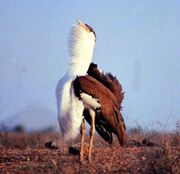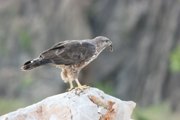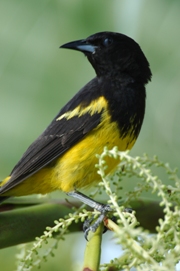Big birds lose out in a crowded world
One of the world’s largest species of bird is on the brink of extinction according to the 2011 IUCN Red List of Threatened Species™for birds, just released by BirdLife International, an IUCN Red List partner.
The Great Indian Bustard (Ardeotis nigriceps) has been uplisted to Critically Endangered, the highest level of threat. Hunting, disturbance, habitat loss and fragmentation have all conspired to reduce this magnificent species to perhaps as few as 250 individuals.
Standing a metre in height and weighing in at nearly 15 kg, the Great Indian Bustard was once widespread across the grasslands of India and Pakistan but is now restricted to small and isolated fragments of remaining habitat.
“In an ever more crowded world, species that need lots of space, such as the Great Indian Bustard, are losing out. However, we are the ones who lose in the long run, as the services that nature provides us start to disappear,” said Dr Leon Bennun, BirdLife’s Director of Science and Policy.
This year’s update brings the total number of threatened bird species to 1,253, an alarming 13% of the world total.
“In the space of a year another 13 bird species have moved into the threatened categories”, said Jean-Christophe Vié, Deputy Director, IUCN Global Species Programme. “This is a disturbing trend; however the figure would be much worse if conservation initiatives were not in place. The information collected by the BirdLife partnership is crucial in helping us to continue improving conservation efforts. This is now more important than ever as the biodiversity crisis is already affecting our wellbeing and will continue to do so unless we do more to stop it.”
“Birds provide a window on the rest of nature. They are very useful indicators of ecosystem health: if they are faring badly, then so is wildlife more generally,” said Dr Stuart Butchart, BirdLife’s Global Research and Indicators Coordinator. “The changes we have documented in this year’s update will feed into the Red List Index for birds, a measure of trends in the state of the planet used by the world governments, global businesses and the United Nations, among others”.
Another species on the edge is the Bahama Oriole (Icterus northropi) also newly listed as Critically Endangered. Recent survey work suggests the population of this beautiful black and yellow Caribbean bird could be as low as 180 individuals. The orioles live in mature woodland, and nest in coconut palms. Lethal yellowing disease of these palms has wiped out nesting trees in areas where the oriole was previously common but is now absent. However, apart from losing nesting habitat, the oriole is also threatened by the recent arrival of the Shiny Cowbird (Molothrus bonariensis) a brood parasite that lays its eggs in other species’ nests.
“Although the situation appears bleak for many species, this year’s update does highlight several species where targeted conservation work has turned around their fortunes,” said Andy Symes, BirdLife’s Global Species Programme Officer.
The Campbell Island Teal, Anas nesiotis, has benefitted from a massive programme to eradicate rats, plus captive-breeding of remaining individuals. The species has now returned to New Zealand’s Campbell Island and the majority of birds are now thriving, resulting in a reclassification of the threat status to Endangered.
Three species of Atlantic island pigeon are also benefitting from conservation. The Madeira, White-tailed and Dark-tailed Laurel Pigeon (Columba trocaz of Madeira and C. junoniae and C. bollii of the Canary Islands) have all been classified at lower threat levels after threats such as habitat loss and hunting were addressed, coupled with an increased protection of suitable habitat.
“Birds are so intertwined with human culture all around the world that they present a very visible picture of the state of nature. Good examples abound of how we can save threatened birds. We need to redouble our efforts to do so, otherwise we risk not just losing magnificent creatures like the Great Indian Bustard, but unravelling the whole fabric of our life-support systems”, said Dr Bennun.
Other regional highlights
Americas
Pale-headed Brush-finch (Atlapetes pallidiceps) has been downlisted from Critically Endangered to Endangered.
Black-backed Thornbill (Ramphomicron dorsale) has been uplisted from Least Concertn to Endangered.
Pacific
Collared Petrel (Pterodroma brevipes) has been uplisted from Near Threatened to Endangered.
Samoan Flycatcher (Myiagra albiventris) has been downlisted from Vulnerable to Near Threatened
Asia
Sula Megapode (Megapodius bernsteinii) has been uplisted from Near Threatened to Vulnerable
White-throated Wren-babbler (Rimator pasquieri) has been uplisted from Least Concern to Endangered
Africa
Secretarybird (Sagittarius serpentarius) has been uplisted from Least Concern to Vulnerable.
Hooded Vulture (Necrosyrtes monachus) has been uplisted from Least Concern to Endangered.
Europe and the Middle East
Lesser Kestrel (Falco naumanni) has been downlisted from Vulnerable to Least Concern
Socotra Buzzard (Buteo socotraensis) is newly described and has been listed as Vulnerable.
To find out more about all these and other species visit www.birdlife.org/datazone/species/search
For more information or interviews please contact:
Martin Fowlie, Communications, BirdLife International t +44 (0)1223 279813 e martin.fowlie@birdlife.org
Borjana Pervan, IUCN Media Relations, t +41 229990115, e +41 79 8574072 e borjana.pervan @iucn.org









